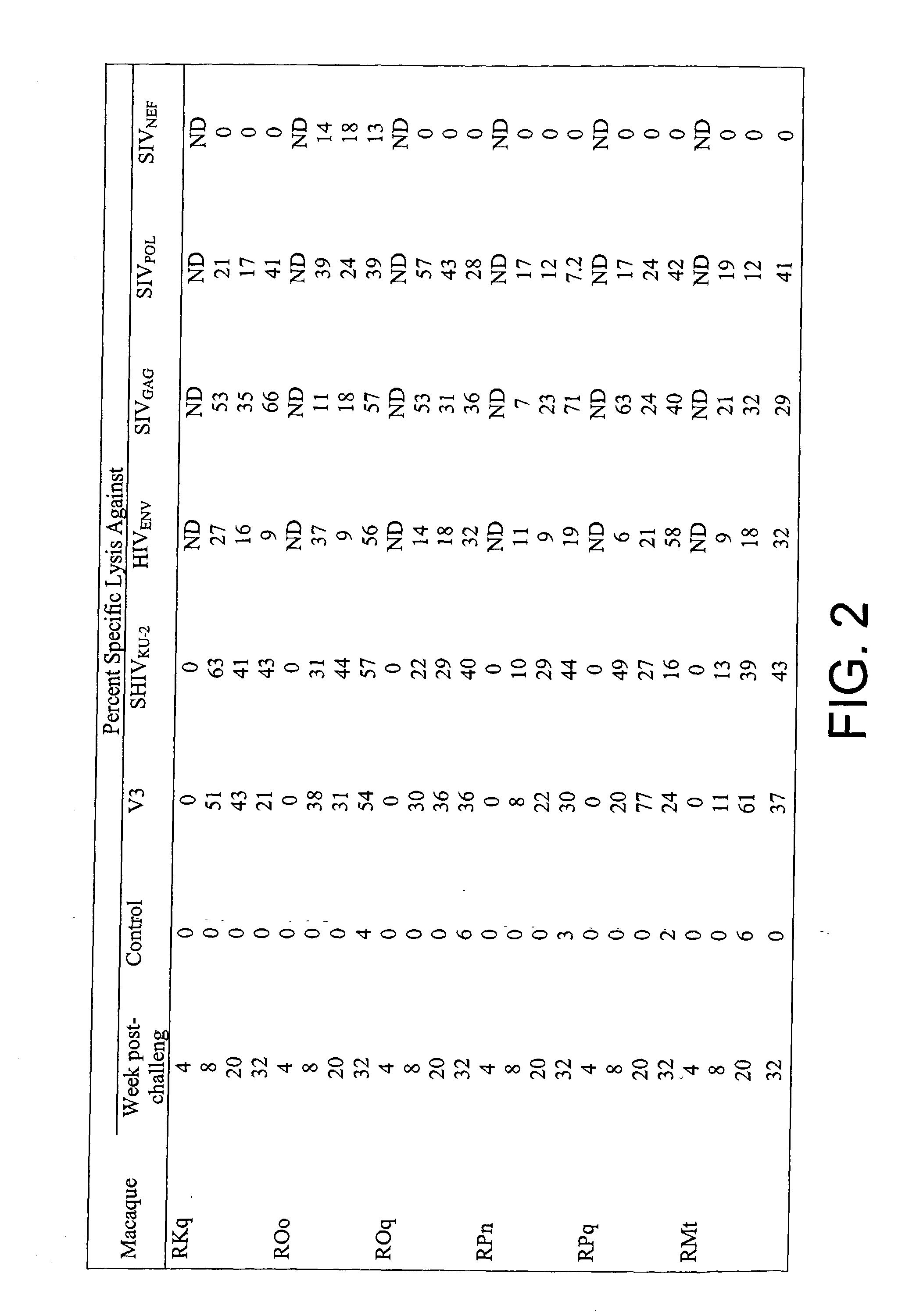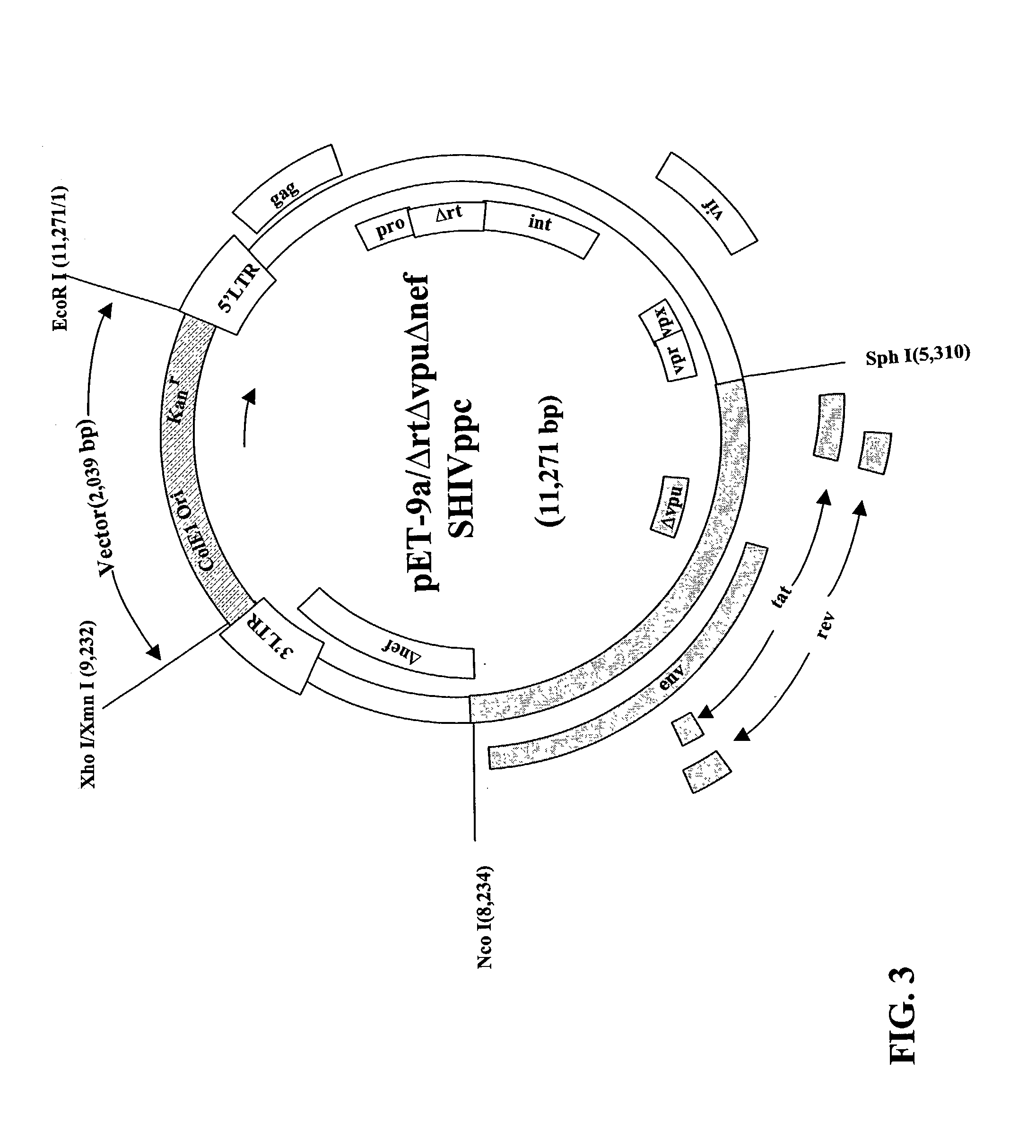HIV vaccine and method of use
a human immunodeficiency virus and vaccine technology, applied in the field of live virus and dna vaccines against the human immunodeficiency virus, can solve the problems of affecting the signaling process of the cell, unable to accurately measure the protective immunity of neutralizing antibodies and cellular immunity, and unable to generate natural immunity of primates. to achieve the effect of inducing a cellular immune respons
- Summary
- Abstract
- Description
- Claims
- Application Information
AI Technical Summary
Benefits of technology
Problems solved by technology
Method used
Image
Examples
example 2
Immunization of Macaques with V2
[0046] This virus was administered orally to a group of six macaques to test its efficacy as a vaccine. Another group of six macaques received the virus intradermally to test the efficacy of that route of vaccine administration. Undiluted virus stock containing approximately 10.sup.3 animal infectious doses (determined by mucosal route titration) was used for the oral inoculation. 100 .mu.g of infectious plasmid DNA was used for the intradermal inoculations. All twelve of the animals became infected by .DELTA.vpuSHIV.sub.PPC. The kinetics of the viral replication, as determined by real-time PCR analysis of viral RNA concentrations in plasma, was indistinguishable in the two groups of animals. The plasma viral RNA concentrations reached levels of approximately 10.sup.5 copies / ml at the height of replication, and productive replication was terminated by 8 weeks post-immunization. All twelve of the macaques developed neutralizing antibodies in plasma and...
example 3
Immunization of Macaques with V3
[0055] Six macaques were inoculated orally with the V3 virus. Two other macaques were inoculated intracerebrally with 100 .mu.g of V3 infectious plasmid DNA (see FIG. 1). All eight of these animals became infected by the V3 virus. A comparison of plasma viral RNA burdens demonstrated that the concentrations and duration in plasma were equivalent among the animals as well as to the values obtained in animals that had been immunized with the V2 virus described above. The cell-mediated immune responses were also equivalent except that the animals immunized with the V3 virus did not develop CTLs against Nef, as the nef gene had been deleted from the V3 virus (FIG. 2 provides data from the detection of long-term CTLs in macaques immunized with the V3 virus). Thus, it was determined that the V3 and V2 viruses were equivalent in their potential to induce protective immunity.
[0056] In order to confirm that the V3 virus would not become pathogenic during passa...
example 4
The Safety of the V3 Vaccine
[0057] Serial inoculations of macaques were performed with the V3 virus and with the parental SHIV.sub.PPC virus described above. A macaque was inoculated intravenously with each virus. Three to four weeks later, 3 ml of heparinized blood from the animal was inoculated into two new recipient macaques. This procedure was repeated for a total of four passages for each virus. The viruses replicated productively in each of the eight animals used in the study. The replication pattern of the V3 virus was constant in each passage, and the productive infection was brought under control in all four animals. None of these animals lost CD4.sup.+ T cells, and all four remained healthy six months following the last passage. The SHIV.sub.PPC virus replicated more productively than the V3 virus and the productive infection persisted. The animal in the first passage, however, remained healthy. This changed in subsequent passages, with animals in passages two, three and f...
PUM
| Property | Measurement | Unit |
|---|---|---|
| Density | aaaaa | aaaaa |
| Density | aaaaa | aaaaa |
| Density | aaaaa | aaaaa |
Abstract
Description
Claims
Application Information
 Login to View More
Login to View More - R&D
- Intellectual Property
- Life Sciences
- Materials
- Tech Scout
- Unparalleled Data Quality
- Higher Quality Content
- 60% Fewer Hallucinations
Browse by: Latest US Patents, China's latest patents, Technical Efficacy Thesaurus, Application Domain, Technology Topic, Popular Technical Reports.
© 2025 PatSnap. All rights reserved.Legal|Privacy policy|Modern Slavery Act Transparency Statement|Sitemap|About US| Contact US: help@patsnap.com



